![]()
![]()
![]()
Use LEFT and RIGHT arrow keys to navigate between flashcards;
Use UP and DOWN arrow keys to flip the card;
H to show hint;
A reads text to speech;
97 Cards in this Set
- Front
- Back
|
Epithelial Tissue |

A layer of cells that forms a superficial covering or an internal lining of a body cavity or vessel |
|
|
Histology |
Study of tissues |
|
|
Epithelial Connective Muscle Nervous |
What are the 4 types of tissues? |
|
|
Tissues |
Collections of similar cells and cell products that perform a limited # of specialized functions |
|
|
Epithelia |
Cellular layers of different types that cover exposed surfaces and line internal cavities and passageways. They don’t have blood vessels and often contain secretory cells, or gland cells, scattered among the other cell types. |
|
|
Glands |
Organized groups of cells or organs that contain epithelial-derived cells that synthesize substances for secretion there are two types. |
|
|
Exocrine Glands Endocrine Glands |
What are the two types of glands |
|
|
Exocrine Glands |
Secrete onto external surfaces or into internal passageways (ducts) that connect to the exterior. |
|
|
Endocrine Glands |
Secrete hormones (chemical messengers) or their inactive precursors (prohormones) into the interstitial fluid that then enter the bloodstream for distribution. |
|
|
Provide physical protection Control permeability Provide sensation Produce specialized secretions |
What are the functions of Epithelial tissue? |
|
|
Neuroepithelium |
A sensory epithelium found in special sense organs that provide the sensations of smell, taste, sight, equilibrium, and hearing |
|
|
The Basement Membrane |
A noncellular structure produced by the basal surface of the epithelium and the underlying connective tissue |
|
|
Basal lamina |
Is an amorphous later that contains glycoproteins. It’s produced by the adjacent layer of epithelial cells. |
|
|
Reticular lamina |
Contains reticular protein fibers and ground substances secreted by the underlying connective tissue cells. It gives basement membrane it’s strength and acts as a filter that restricts diffusion between adjacent tissues and the epithelium |
|
|
Hemidesmosomes |
Attach the deepest epithelial cells to the basement membrane. At hemidesmosome, the basal cytoskeleton is locked to peripheral proteins that are firmly attached to a layer of extracellular protein filaments and fibers. |
|
|
Avascular |
Lack blood vessels |
|
|
Yes |
Are epithelia avascular? |
|
|
Squamous Epithelium |
Thin, flat, and somewhat irregularly shaped, like pieces of a jigsaw puzzle. Form the surface, the cells resemble fried eggs laid side by side. In sectional view, the disc-shaped nucleus occupies the thickest portion of each cell. |
|
|
Simple epithelium |

Only one layer of cells is present |
|
|
Stratified epithelium |
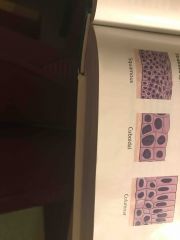
Contains several layers of cells |
|
|
Endothelium |
Simple squamous epithelium lining the inner surface of the heart and all the blood vessels |
|
|
Apical |
What kind of surface does an epithelium have? |
|
|
Stratified squamous epithelium |
Generally located where physical or chemical stresses are severe. The cells form a series of layer, like the layers in a sheet of plywood. They form the surface of the skin and line the mouth, throat, esophagus, rectum, anus, and vagina. |
|
|
Keratinized |
Superficial layer that is both tough and water resistant |
|
|
Nonkeratinized |
Stratified squamous epithelium resists abrasion but will dry out and deteriorate unless kept moist. Are found in the mouth, pharynx, esophagus, anus, and vagina |
|
|
Cuboidal epithelium |
Resemble hexagonal boxes. The spherical nuclei are near the center of each cell, and the distance between adjacent nuclei is roughly equal to the height of the epithelium. |
|
|
Simple cuboidal epithelium |
Provides limited protection and occurs where secretion or absorption takes place. Such an Epithelium lines portions of the kidney tubules. They also like secretory chambers in the thyroid gland. |
|
|
Simple Squamous Epithelium |
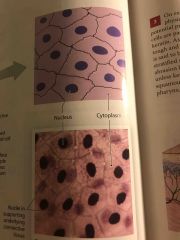
Body’s most delicate type of epithelium. This type of epithelium is located in protected regions where absorption or diffusion takes place or where a slick, slippery surface reduces friction. Found along passageways in the kidneys, inside the eye, and at gas exchange surfaces(aveoli) of the lungs. |
|
|
Transitional epithelium |
Is an unusual stratified epithelium. Unlike most epithelia, it tolerates repeated cycles of stretching without damage. The appearance of the epithelium changes as stretching occurs. It lines the urinary bladder, the ureters, and the urine-collecting chambers within the kidneys, where large changes in volume occur. |
|
|
Columnar epithelium |
Appear rectangular. In reality, the densely packed cells are hexagonal, but they are taller and more slender than cells in a cuboidal epithelium. The elongated nuclei are crowded into a narrow band close to the basement membrane. The height of the epithelium is several times the distance between adjacent nuclei |
|
|
Stratified squamous epithelium |
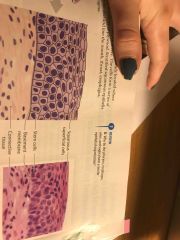
Generally located where physical or chemical stresses are severe. The cells form a series of layer, like the layers in a sheet of plywood. They form the surface of the skin and line the mouth, throat, esophagus, rectum, anus, and vagina. |
|
|
Pseudostratified columnar epithelium |
Includes several types of cells with varying shapes and functions. The distance between the cell nuclei and the exposed surface vary, so the epithelium appears to be layered, or stratified. It is not truly stratified, however because every epithelial cell contacts the basement membrane. Pseudostratified columnar epithelial cells typically have motile cilia. They line the nasal cavities, the trachea, and larger airways of the lungs and are also found along portions of the male reproductive tract. |
|
|
Apical surface |
Faces the exterior of the body or some internal space and a base, which is attached to adjacent tissues. |
|
|
Stratified columnar epithelia |
Not widely distributed in the body. These epithelia may have 2 or more layers. Only the superficial cells are columnar in shape. They are most often found lining the large ducts such as those of the salivary glands or pancreas. |
|
|
Simple cuboidal epithelium |

Provides limited protection and occurs where secretion or absorption takes place. Such an Epithelium lines portions of the kidney tubules. They also like secretory chambers in the thyroid gland. |
|
|
Stratified cuboidal epithelium |
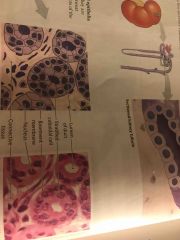
Are relatively rare. They are located along the ducts of sweat glands and in the larger ducts of the mammary glands. |
|
|
Transitional epithelium |
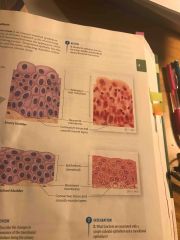
Is an unusual stratified epithelium. Unlike most epithelia, it tolerates repeated cycles of stretching without damage. The appearance of the epithelium changes as stretching occurs. It lines the urinary bladder, the ureters, and the urine-collecting chambers within the kidneys, where large changes in volume occur. |
|
|
Ducts |
Passageways that open onto an epithelial surface. |
|
|
Simple columnar Epithelium |
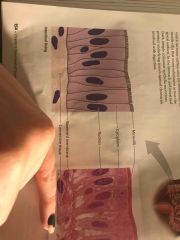
Typically found where absorption or secretion take place, as in the small intestine. These epithelia also line the stomach, gallbladder, uterine tubes, and ducts within the kidneys. These cells may have microvilli, which increase surface area for absorption, or motile cilia they move substances across the apical surface. In the stomach and intestinal tract, simple columnar epithelia secretions protect underlying tissues against chemicals involved with digestion. |
|
|
Pseudostratified columnar epithelium |
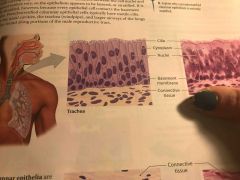
Includes several types of cells with varying shapes and functions. The distance between the cell nuclei and the exposed surface vary, so the epithelium appears to be layered, or stratified. It is not truly stratified, however because every epithelial cell contacts the basement membrane. Pseudostratified columnar epithelial cells typically have motile cilia. They line the nasal cavities, the trachea, and larger airways of the lungs and are also found along portions of the male reproductive tract. |
|
|
Stratified columnar epithelia |
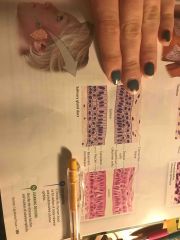
Not widely distributed in the body. These epithelia may have 2 or more layers. Only the superficial cells are columnar in shape. They are most often found lining the large ducts such as those of the salivary glands or pancreas. |
|
|
Apocrine secretion |
Involves the loss of cytoplasm as well as the secretory product. The apical portion of the cytoplasm becomes packed with secretory vesicles and is then shed. Milk production in the mammary glands involves a combination of merocrine and apocrine secretions. |
|
|
Holocrine secretion |
Destroys the gland cell. The entire cell becomes pack with the secretory products and the burst, releasing the secretion killing the cell. Further secretion depends on the replacement of the destroyed cells through stem cell division. Sebaceous glands, associated with hair follicles, produce an oily coating by mean of holocrine secretion. |
|
|
Base |
Is attached to adjacent tissues |
|
|
Multicellular exocrine galnds |
The structure of the duct, the shape of the secretory area of the gland, and the relationship between the duct and the secretory areas. |
|
|
Merocrine secretion |
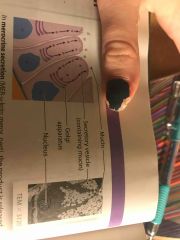
The product is released from secretory vesicles by exocytosis. The most common mode of exocrine secretion. |
|
|
Compound gland |
The duct divides one or more times on its way to the gland cells |
|
|
Alveolar/ acinar |
Glands whose glandar cells form sac-like pockets |
|
|
Apocrine secretion |
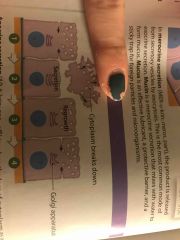
Involves the loss of cytoplasm as well as the secretory product. The apical portion of the cytoplasm becomes packed with secretory vesicles and is then shed. Milk production in the mammary glands involves a combination of merocrine and apocrine secretions. |
|
|
Holocrine secretion |
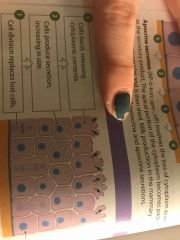
Destroys the gland cell. The entire cell becomes pack with the secretory products and the burst, releasing the secretion killing the cell. Further secretion depends on the replacement of the destroyed cells through stem cell division. Sebaceous glands, associated with hair follicles, produce an oily coating by mean of holocrine secretion. |
|
|
Connective tissue |
Occur through the body but are never exposed to the outside environment. Many types of ____ are highly vascular and contain sensory receptors that detect pain, pressure, temperature, and other stimuli |
|
|
Connective tissue proper |
Includes those connective tissues with many types of cells and extracellular fibers in a syrupy ground substance. |
|
|
Loose Dense |
What are the two types of connective tissue proper |
|
|
Loose connective tissue proper |
Fibers create loose, open framework. Areolar tissue. Adipose tissue, reticular tissue |
|
|
Polarity |
Refers to the presence of structural and functional differences between the exposed and attached surfaces |
|
|
Sense connective tissue proper |
Fibers densely packed. Dense regular. Dense irregular. Elastic |
|
|
Fluid connective tissue |
Have distinct populations of cells suspended in a watery matrix that contains dissolved proteins. |
|
|
Blood Lymph |
What are the two types of fluid connective tissue |
|
|
Blood |
Flows within cardiovascular system |
|
|
Lymph |
Flows within lymphatic system |
|
|
Supporting connective tissue |
Differ from connective tissue proper in having a less diverse cell population and a matrix containing much more densely packed fibers. Supporting connective tissues protect soft tissues and support the weight of part or all of the body. |
|
|
Cartilage Bone |
What are the two types of supporting connective tissues |
|
|
Cartilage |
Solid, rubbery matrix. Hyaline cartilage. Elastic cartilage. Fibrocartilage. |
|
|
Bone |
Solid, crystalline matrix |
|
|
Areolar tissue Adipose tissue Reticular tissue |
What are the types of loose connective tissue? |
|
|
Lumen |
A passageway |
|
|
Areolar tissue |
Is the least specialized and most common form of connective tissue proper in adults. It’s the general packing material in the body. All of the cell types found in other forms of connective tissue proper can be found in this tissue |
|
|
Mast cells |
Fixed cells that’s stimulate local inflammation and mobilize tissue defenses |
|
|
Fibroblast |
Secrete hyaluronic acid and proteins that form the ground substance and create the extracellular fibers. |
|
|
Fibrocytes |
Differentiate from fibroblasts and maintain the extracellular fibers. |
|
|
Melanocytes |
Pigment cells that synthesize melanin, a brownish yellow pigment. |
|
|
Adipocytes |
(Fat cells) are fixed cells that store lipids in large intracellular vesicles. |
|
|
Plasma cells |
Are active, mobile immune cells that produce antibodies. |
|
|
Mesenchymal cells |
Are mobile stem cells that repair damaged tissues. |
|
|
Lymphocytes |
Are mobile cells of the immune system. |
|
|
Adipose tissue |
Is found deep to the skin, especially at the flanks, buttocks, and breasts. It also forms a layer that provides padding within the orbit of the eyes, in the abdominopelvic cavity, and around the kidneys. The distinction between areolar tissue and ____ is somewhat arbitrary. Adipocytes account for most of the volume of _____, but only a fraction of the volume of areolar tissue. |
|
|
Basolateral surfaces |
Include both the base, where the cell attaches to the underlying epithelial cells or deeper tissues, and the sides, where the cell contacts its neighbors. |
|
|
Reticular tissue |
Is found in the liver, kidneys, spleen spleen, lymph nodes, bone marrow, where it forms a tough,flexible network that provide support and resists distortion. In ____, reticular fibers create a complex 3- dimensional supporting network know as a strops. |
|
|
Dense regular connective tissue |
Is found in the cords (tendons) or sheets connecting skeletal muscles to bone, and in cords(ligaments) that interconnect bones or stabilize the positions of internal organs. The forces applied to these cords and sheets arrive from a consistent direction:parallel to the long axis of the collagen fibers. |
|
|
Adipose tissue |
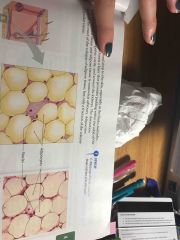
Is found deep to the skin, especially at the flanks, buttocks, and breasts. It also forms a layer that provides padding within the orbit of the eyes, in the abdominopelvic cavity, and around the kidneys. The distinction between areolar tissue and ____ is somewhat arbitrary. Adipocytes account for most of the volume of _____, but only a fraction of the volume of areolar tissue. |
|
|
Reticular tissue |

Is found in the liver, kidneys, spleen spleen, lymph nodes, bone marrow, where it forms a tough,flexible network that provide support and resists distortion. In ____, reticular fibers create a complex 3- dimensional supporting network know as a strops. |
|
|
Dense regular connective tissue |
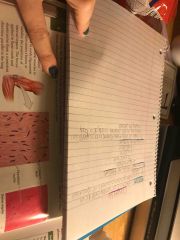
Is found in the cords (tendons) or sheets connecting skeletal muscles to bone, and in cords(ligaments) that interconnect bones or stabilize the positions of internal organs. The forces applied to these cords and sheets arrive from a consistent direction:parallel to the long axis of the collagen fibers. |
|
|
Simple epithelium |
Only one layer of cells is present |
|
|
Dense irregular connective tissue |
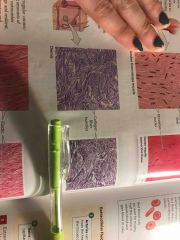
The fibers form an interwoven meshwork in no consistent pattern. These tissues strengthen and support areas subjected to stresses from many directions. _____ forms 1. A covering or capsule, that sheathes visceral organs. 2. A superficial layer covering bones, cartilages, and peripheral nerves; and 3. A thick supporting layer in the skin (the dermis) |
|
|
Elastic tissue |

Found between vertebrae of the spinal column, in the walls of large blood vessels, in ligaments supporting transitional epithelia, and the erectile tissue of the penis. |
|
|
Red blood cells |
Formed elements that transport oxygen (and, to a lesser degree, carbon dioxide) in the blood. They account for roughly half the volume of whole blood and give blood it’s color |
|
|
White blood cells |
Are formed elements that help defend the body from infections and disease |
|
|
Monocytes |
Are phagocytes similar to the free macrophages in other tissues. |
|
|
Lymphocytes |
Are uncommon in the blood, but they are the dominant cell type in lymph, the second type of fluid connective tissue. Jwje |
|
|
Hyaline cartilage |
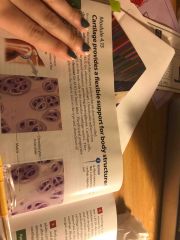
Is found between the tips of the ribs and the bones of the sternum covering bone surfaces at movable joints, supporting the respiratory passageways, and forming part of the nasal septum. It provides stuff but somewhat flexible support and reduces friction between bony surfaces. |
|
|
Elastic cartilage |
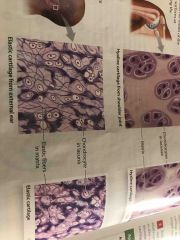
Supports the external war and a number of smaller internal structures. It’s numerous elastic fibers allow it to distort without damage and return to its original shape. |
|
|
Fibrocartilage |
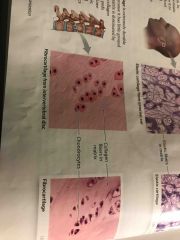
Is extremely durable and tough because it has little ground substance and it’s matrix is dominated by densely interwoven collagen fibers. ____ pads are found within the knee joints, between the pubic bones of the pelvis and in the intervertebral discs of the vertebral column. It resists compression prevents bone to bone contact and limits relative movement. |
|
|
Appositional growth |
Adds new layers of cartilage to the surface |
|
|
Appositional growth |
Adds new layers of cartilage to the surface |
|
|
Interstitial growth |
Enlarged the cartilage from within |
|
|
Appositional growth |
Adds new layers of cartilage to the surface |
|
|
Interstitial growth |
Enlarged the cartilage from within |

